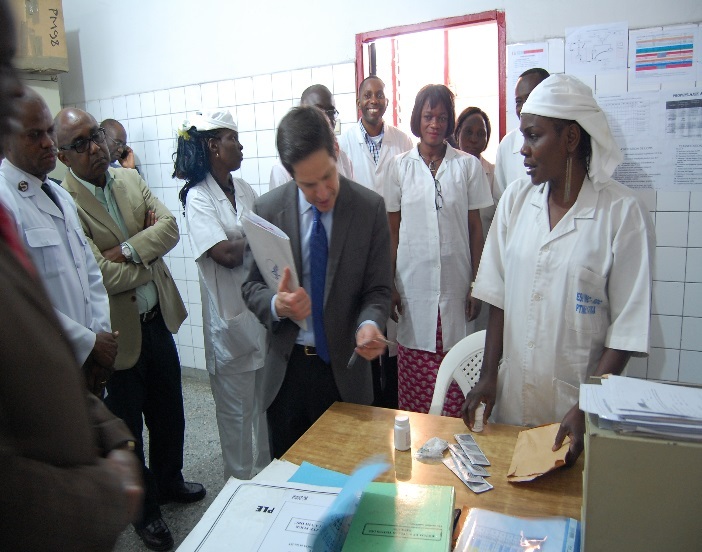When treating infectious diseases, health workers must be experts in protocols for effectively attending to patients while protecting their own health. This was a primary message delivered by Tom Frieden, M.D., the director of the U.S. Centers for Disease Control and Prevention (CDC), to health workers in the Democratic Republic of the Congo (DRC) where HIV and tuberculosis (TB) are continuing threats to public health.
“In healthcare, there are problems we do see and there are problems we do not see,” Dr. Frieden told a group of public health officials and health workers at the Salvation Army’s Bomoi Health Center in Kinshasa on Aug. 8. “It is important to pay attention to the problems we do not see in order to protect ourselves as health care providers and our patients.”
The Bomoi Health Center is one of the most comprehensive sites in DRC supported by the Elizabeth Glaser Pediatric AIDS Foundation (EGPAF), with funding from the CDC through the U.S. President’s Emergency Plan for AIDS Relief (PEPFAR). It is the first health care facility in DRC to be visited by Dr. Frieden. One of the noteworthy aspects of the facility is the integration of care and treatment for HIV and tuberculosis (TB), two infectious diseases that often present togother.
“TB infection control is a component of the antenatal and postpartum care for HIV-positive women and HIV-exposed children,” explained John Ditekemena, M.D., the EGPAF-DRC country director. “Quality care depends upon how protocols are observed. We post standard operating procedures in rooms for consultation, treatment, and antenatal care; we monitor the facility’s measures for controlling infectious diseases; and we promote biomedical security—all to protect staff and patients.”
As Dr. Frieden toured the HIV/AIDS care and treatment unit, health workers led him through the circuit that an HIV patient normally takes: moving from the reception desk to consultation rooms, the psychosocial support room, and the pharmacy. Along the way, Dr. Frieden stopped for confidential chats with HIV-positive patients.
Dr. Frieden then met other HIV-positive patients who were participating in a support group meeting at the health facility. He encouraged them to continue to adhere to their antiretroviral treatment, which is the only way to ensure that they lead healthy lives. He also assured them of the United States’ commitment to continued international support.
After the HIV unit, Dr. Frieden conducted a similar tour of the antenatal circuit. He visited the maternal, newborn, and child health (MNCH) and HIV collective counseling room, where many pregnant women were participating in education sessions regarding prevention of mother-to-child transmission of HIV (PMTCT). He followed the journey of new mothers, from individual counseling and testing for HIV, to post-test counseling, to care and treatment for HIV, and, finally, to immunization of children.
Dr. Frieden ended his visit at the laboratory, where he looked at a sputum smear reading and spotted the presence of acid fast bacilli, which identifies tuberculosis (TB). Dr. Frieden remarked that he used to work with TB treatment, so he was quite familiar with the protocols. He noted that TB and HIV are similar because both require rigorous monitoring and adherence to treatment.
At each stage of the visit, Dr. Frieden provided technical advice where it was necessary, making recommendations on how to improve existing TB infection control measures, such as the air circulation in one of consultation rooms.
“I am very pleased to see the high quality service you are doing here, and that you are involving patients in their own care because this will be an effective way to provide them with good quality services,” concluded Dr. Frieden. “Thank you for the good job you are doing.”




